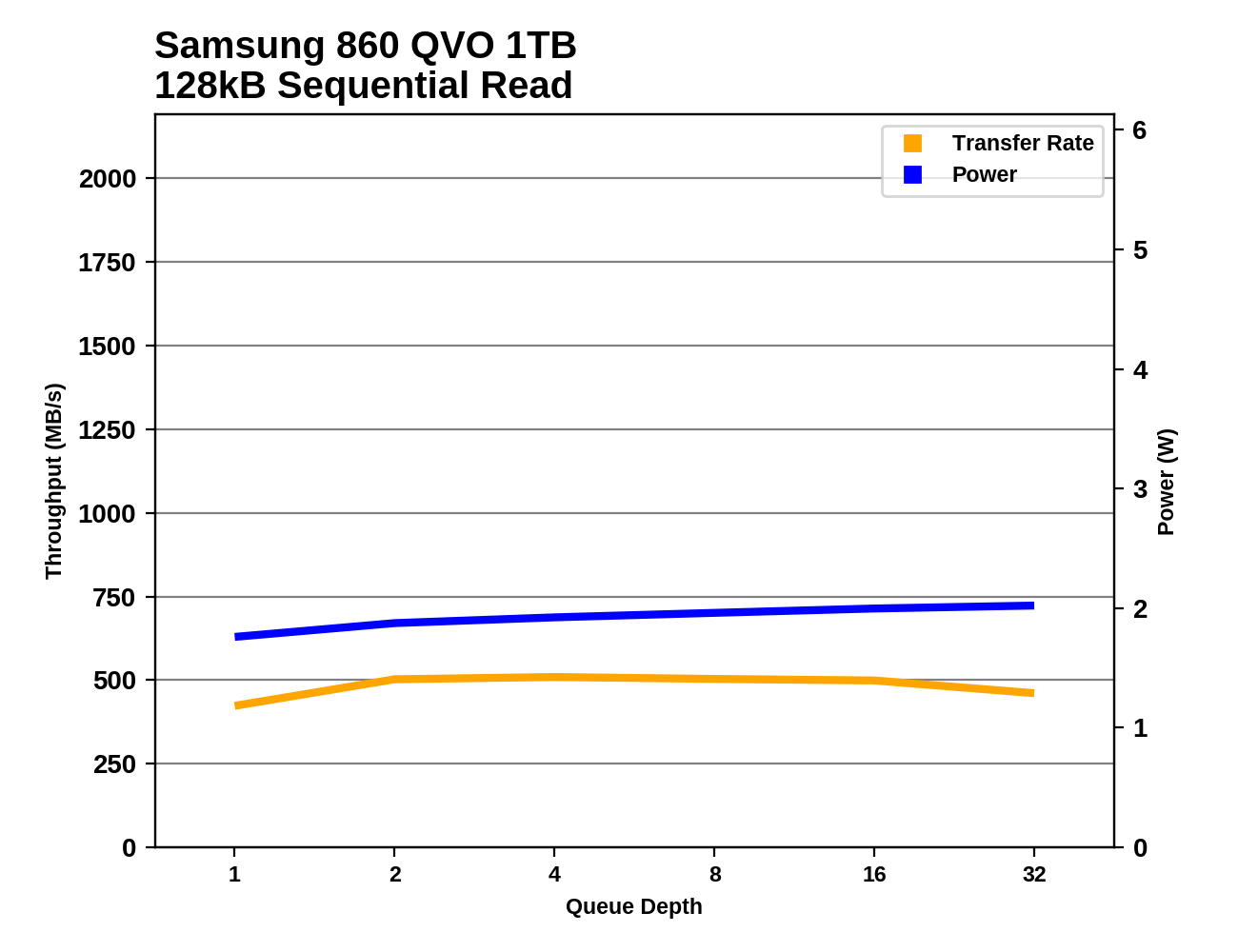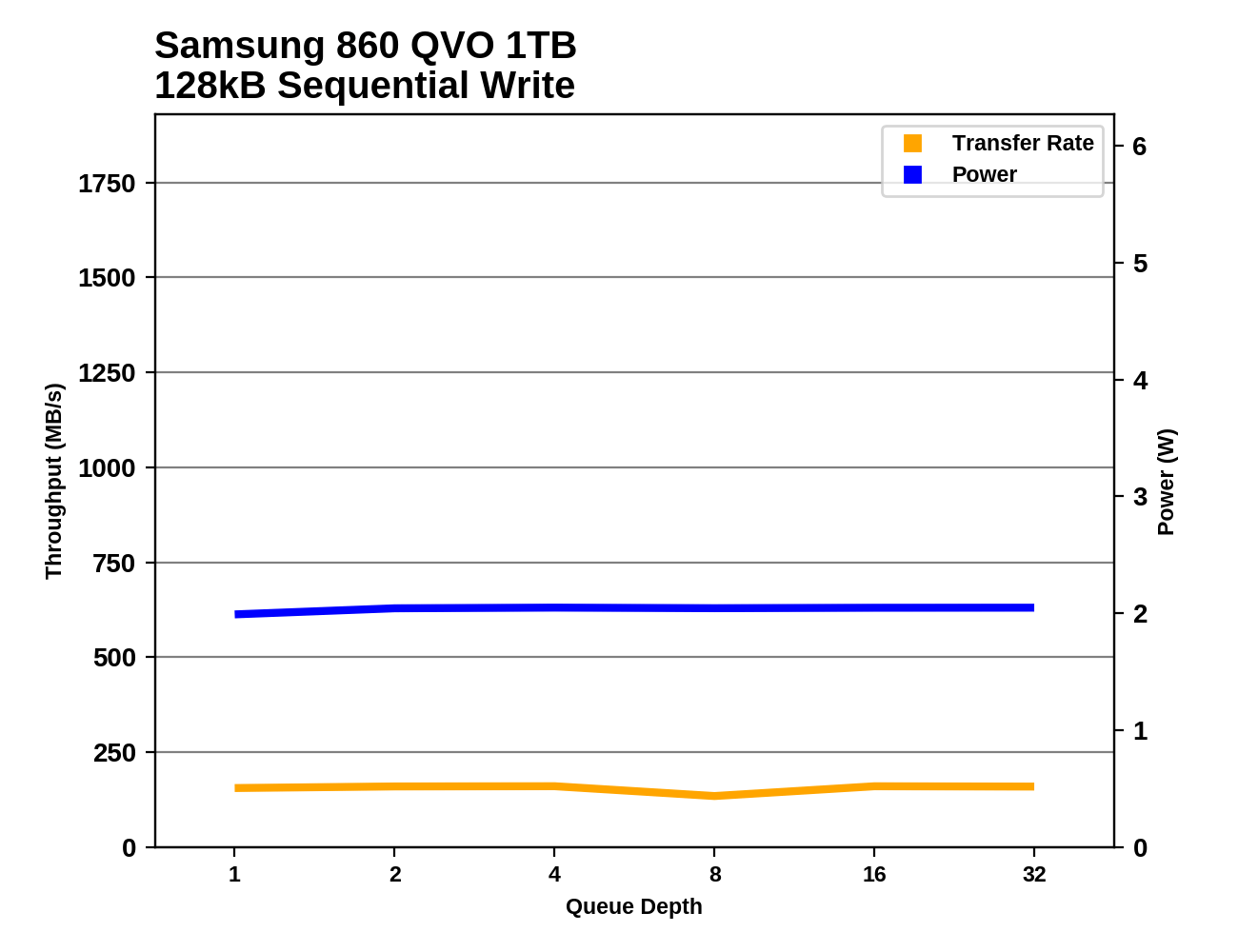The Samsung 860 QVO (1TB, 4TB) SSD Review: First Consumer SATA QLC
by Billy Tallis on November 27, 2018 11:20 AM ESTSequential Read Performance
Our first test of sequential read performance uses short bursts of 128MB, issued as 128kB operations with no queuing. The test averages performance across eight bursts for a total of 1GB of data transferred from a drive containing 16GB of data. Between each burst the drive is given enough idle time to keep the overall duty cycle at 20%.

The burst sequential read performance of the Samsung 860 QVO is generally competitive with mainstream TLC SATA SSDs and is well ahead of the DRAMless Toshiba TR200. The 1TB 860 QVO's score is a bit lower when the drive isn't full because of the timing of the tests: the drive was still flushing the SLC cache in the background when the read test started.
Our test of sustained sequential reads uses queue depths from 1 to 32, with the performance and power scores computed as the average of QD1, QD2 and QD4. Each queue depth is tested for up to one minute or 32GB transferred, from a drive containing 64GB of data. This test is run twice: once with the drive prepared by sequentially writing the test data, and again after the random write test has mixed things up, causing fragmentation inside the SSD that isn't visible to the OS. These two scores represent the two extremes of how the drive would perform under real-world usage, where wear leveling and modifications to some existing data will create some internal fragmentation that degrades performance, but usually not to the extent shown here.

On the longer sequential read test, the 860 QVO continues to get reasonably close to the SATA speed limit when reading data that is contiguous on the flash itself. Where internal fragmentation is caused by writing to the drive randomly, the QVO's read speed suffers much more than for the TLC drives, and the 1TB 860 QVO ends up slightly slower than a mechanical hard drive.
 |
|||||||||
| Power Efficiency in MB/s/W | Average Power in W | ||||||||
The power efficiency of the 860 QVO is only a little bit lower than the TLC drives for the contiguous data case. When dealing with fragmented data, the QVO is slightly more efficient than the Intel/Micron NVMe QLC drives despite being a bit slower.
 |
|||||||||
The queue depth scaling behavior for the 860 QVO is very typical, with QD1 not quite saturating the SATA link but all higher queue depths hitting close to full speed. The one exception is a slight decrease from the 1TB drive during the final QD32 phase.
Aside from the mild QD32 drop in performance, the sequential read behavior of the 860 QVO doesn't fall outside the normal ranges we've come to expect from TLC drives.
Sequential Write Performance
Our test of sequential write burst performance is structured identically to the sequential read burst performance test save for the direction of the data transfer. Each burst writes 128MB as 128kB operations issued at QD1, for a total of 1GB of data written to a drive containing 16GB of data.

The Samsung 860 QVO handles the burst sequential write test fine when the drive is mostly empty and there's plenty of room in the SLC cache. When the drive is full, the 1TB model's speed suffers somewhat, but is still much faster than the mechanical hard drive or the DRAMless TLC drive.
Our test of sustained sequential writes is structured identically to our sustained sequential read test, save for the direction of the data transfers. Queue depths range from 1 to 32 and each queue depth is tested for up to one minute or 32GB, followed by up to one minute of idle time for the drive to cool off and perform garbage collection. The test is confined to a 64GB span of the drive.

On the longer sequential write test, the SLC cache of the 1TB 860 QVO is not quite enough even when the drive is mostly empty, so it ends up in last place. The 4TB model's SLC cache keeps up with this test and it is as fast as any SATA drive.
 |
|||||||||
| Power Efficiency in MB/s/W | Average Power in W | ||||||||
The 860 QVO is a bit more power-hungry than the 860 EVO, so the 4TB QVO only takes third place for efficiency among the SATA drives in this bunch. The 1TB QVO has similar efficiency to the faster but more power-hungry 1TB QLC NVMe drives from Intel and Micron.
 |
|||||||||
The 1TB 860 QVO is mostly slow and steady during the sequential write test, while the 4TB model's performance is as good as any other SATA drive.
The 1TB 860 QVO's sequential write behavior sticks out clearly as far slower than typical, but it's not unprecedented: there have been TLC drives this slow, but most of them were much smaller than 1TB. The 4TB model blends in with the crowd much better.












109 Comments
View All Comments
nathanddrews - Tuesday, November 27, 2018 - link
Still leaps and bounds beyond 7200RPM hard drives, but not great either. If we could just get to SATA3 equivalent performance at this price/GB, it would be great. 4TB for that cheap is pretty awesome though, I might grab one if it goes on sale.Makaveli - Tuesday, November 27, 2018 - link
Your review conclusion was much easier on this drive than the Tech Report review.Basically buy a 860Evo this drive is trash is what I get when I read all the reviews on the net today. Only people that don't follow the industry will be suckered into buying these because of that attractive low price.
Like everything in this world you get what you pay for.
Billy Tallis - Tuesday, November 27, 2018 - link
I didn't want to over-emphasize the price issue because I don't think that situation will last very long. Samsung may end up dropping prices before the QVO even hits the shelves, and within a few months I think it will be significantly cheaper than the EVO, which means it should also be cheaper than all the other mainstream TLC drives and the handful of high-capacity DRAMless TLC drives. Once the novelty wears off and the pricing settles down, I fully expect the QVO to end up being a very reasonable entry-level buy.hanselltc - Wednesday, November 28, 2018 - link
It'll not only have to be significantly cheaper than the EVO series -- I think it'll have to compete with HDD arrays.The_Assimilator - Thursday, November 29, 2018 - link
This sort of forward-thinking bigger-picture non-knee-jerk reviewing is why I keep coming back to AnandTech. People can pan this drive and QLC all they want, but Samsung's gonna be laughing all the way to the bank once QLC starts eating HDDs' lunch, and then those same sites that trashed them will be calling them visionary.BTW Billy, please do keep us updated on the 4TB failures you saw - since that capacity is likely going to be the best in terms of cost/GB, a lot of people will be considering 4TB Samsung SSDs, and if there is a controller/firmware/NAND issue lurking it would be great to know about it beforehand.
AbRASiON - Tuesday, November 27, 2018 - link
Hi,I know it's an odd request but I don't follow reviews as much as I used to.
I'd love to see a couple of graphs on this chart, just showing perhaps a very early generation SSD or even a regular high end 7200RPM hard drive.
Scale is all but lost when you don't recognise the disks it's comparing against.
I know the 860/960 Evos are powerful, I can see this disk is much slower, but will it totally destroy a hard drive or Intel G2 160GB classic in all benchmarks? Etc
TekWiz - Tuesday, November 27, 2018 - link
Well sure it will destroy a hard drive! It's slower than the EVO but still is a pretty good SSD. It's aimed at people who want high capacity for as least money as possible. I bet if the list price is $150, it will probably end up costing about $20 less than an equivalent EVO.It's like comparing the PRO to the EVO, it's more expensive but has higher performance. But any of these quality SSD totally beat spinning disks particularly when it's not just sequential reads. In normal use, sequential reads are less common than the arm of the drive going back and forth over the surface reading blocks from all over the place, and you can hear it like a chattering sound, sometimes annoying. Those reads slow the drive down to a crawl usually. That's what makes the SSD so superior, there is no waste of time while a mechanical arm positions itself repetitively over various blocks on a spinning surface. On an SSD all the data is equally instantly available no matter where it exists in the cell matrix in the chips...
hanselltc - Wednesday, November 28, 2018 - link
Why would I want these over a HDD though? Say, a SSHD.CheapSushi - Wednesday, November 28, 2018 - link
Honestly I'd like for SSHDs to get a reboot, especially with this higher capacity QLC that also acts like SLC when needed. The current SSHDs I think have a max of 8GB of NAND and 2TB (I think) of platter. I'd love to see maybe 128GB of NAND and 4TB or 5TB of platter, at least for 2.5" form factor.Darcey R. Epperly - Wednesday, November 28, 2018 - link
And a reserved area guaranteed to be NAND, the rest for caching.